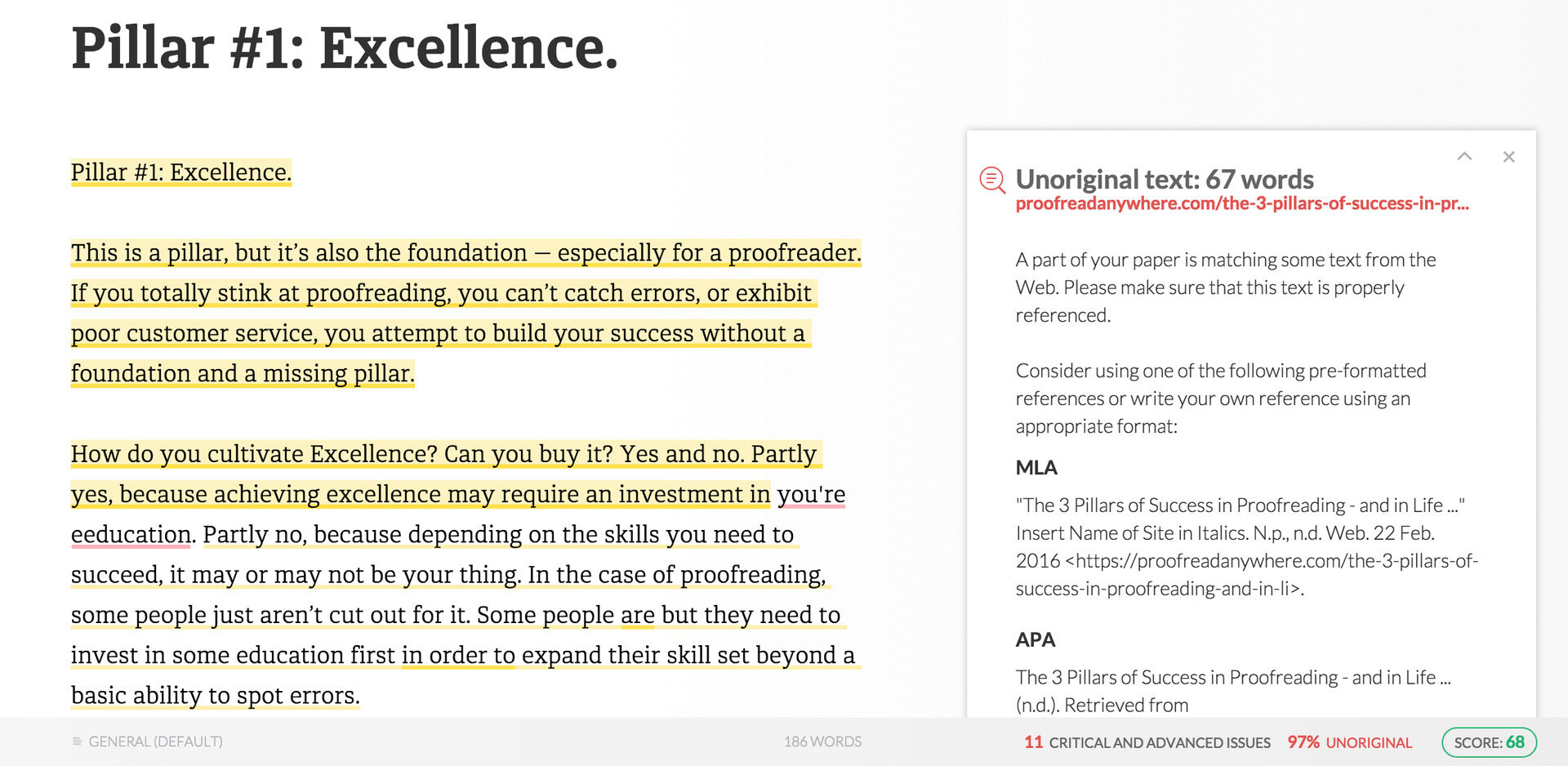Introduction
Welcome to our guide on correcting passive voice misuse in Grammarly. As writers, it’s important to have a strong understanding of proper grammar and sentence structure to effectively convey our ideas. Passive voice misuse is a common problem that can hinder the clarity and impact of our writing. With the help of Grammarly, a popular writing tool, we can easily identify passive voice errors and learn how to correct them.
Before we delve into the specifics, let’s establish what exactly constitutes passive voice. In grammatical terms, passive voice occurs when the subject of a sentence is being acted upon rather than performing the action itself. This results in a sentence that is less direct and less engaging for the reader. Understanding the incorrect use of passive voice is crucial for improving the quality of our writing.
So why is passive voice misuse a problem? Firstly, it can make our writing sound clunky and awkward. Passive voice often leads to wordiness and ambiguity, making it challenging for readers to understand our intended meaning. Additionally, passive constructions can weaken the impact of our statements by removing the active agent from the sentence. By addressing passive voice misuse, we can enhance the readability and effectiveness of our writing.
In this guide, we will explore how to identify passive voice misuse using Grammarly’s helpful features. We will also provide you with practical tips to correct and improve your writing. By following these guidelines, you’ll learn how to express your ideas more clearly, maintain a consistent writing style, and ultimately captivate your readers with powerful and engaging content.
What is Passive Voice?
Before we dive into correcting passive voice misuse, let’s first understand what passive voice actually means. In grammar, passive voice is a sentence construction where the subject receives the action of the verb rather than performing the action itself. In simpler terms, it’s when the object of a sentence is emphasized more than the subject.
To identify passive voice, we look for two key components: the form of the verb and the sentence structure. In passive voice, the verb is typically formed using a form of the auxiliary verb “to be” (such as “is,” “was,” “were,” “has been”) followed by the past participle form of the main verb (e.g., “written,” “completed,” “seen”).
For example, consider the sentence: “The book was written by John.” In this sentence, the book is the subject, but it is not performing the action of writing; instead, it is being acted upon. John, on the other hand, is the agent of the action, but he is not the subject of the sentence.
Passive voice can be useful in certain contexts, such as when the doer of the action is unknown or unimportant. However, excessive use of passive voice can make writing sound dull, impersonal, and less engaging. It can also lead to wordiness and ambiguity, making it harder for readers to understand the intended meaning.
To improve the clarity and impact of our writing, it’s important to avoid passive voice whenever possible. Active voice, the opposite of passive voice, emphasizes the subject and makes the sentence clearer, more direct, and more engaging for readers. By using active voice, we can create stronger sentences that grab the readers’ attention and effectively convey our intended message.
Why is Passive Voice Misuse a Problem?
Passive voice misuse can have a significant impact on the clarity and effectiveness of our writing. Let’s explore the reasons why it is important to address passive voice misuse.
Firstly, passive voice can make our writing sound weak and indirect. By shifting the focus from the subject to the object of the sentence, passive constructions can result in sentences that lack impact and fail to engage the reader. This can undermine the effectiveness of our message and lead to a disconnect between the writer and the audience.
Moreover, passive voice often leads to wordiness and ambiguity. Passive constructions tend to use more words, as they require the addition of auxiliary verbs and the past participle form of the verb. This not only makes our sentences longer, but it can also make them harder to understand. Passive voice can obfuscate the intended meaning, leading to confusion or misunderstandings for the reader.
Another reason why passive voice misuse is problematic is that it can obscure the responsibility or agency of the subject. By omitting the doer of the action, passive voice constructions may create a sense of vagueness or detachment. This lack of transparency can undermine the credibility and accountability of our writing.
Finally, consistent use of passive voice can disrupt the overall flow and coherence of a piece of writing. It creates a disjointed reading experience and can cause the reader to lose interest or become disengaged. Active voice, on the other hand, allows for a smoother and more natural progression of ideas, facilitating better comprehension and retention.
In summary, passive voice misuse is a problem because it weakens the impact of our writing, leads to wordiness and ambiguity, obscures responsibility and agency, and disrupts the flow of our ideas. By actively avoiding passive voice and striving for clear and direct language, we can produce stronger, more engaging, and more effective pieces of writing. Let’s now explore how we can identify and correct passive voice misuse using Grammarly.
How to Identify Passive Voice Misuse in Grammarly
Grammarly, a popular writing tool, can assist us in detecting passive voice misuse in our writing. It offers various features and suggestions that help us identify and correct passive voice errors. Here’s how we can use Grammarly to identify passive voice misuse:
- Grammarly’s Passive Voice Checker: Grammarly’s advanced algorithms analyze our writing and flag instances of passive voice. When we run our text through Grammarly, it highlights passive voice constructions and provides suggestions for correction. This feature not only saves us time but also helps us develop a better understanding of passive voice and its applications.
- In-Context Explanations: Grammarly offers in-context explanations for the passive voice errors it detects. These explanations help us understand why a specific sentence or phrase is considered passive voice. By providing clear and concise explanations, Grammarly enables us to grasp the concepts behind passive voice misuse and make informed decisions when revising our writing.
- Writing Style Suggestions: In addition to explicitly pointing out passive voice errors, Grammarly also provides general writing style suggestions. These suggestions might include advice on how to rephrase or restructure a sentence to make it more concise, engaging, and active. By following these suggestions, we can improve both our writing style and our ability to identify passive voice misuse independently.
- Grammarly Browser Extension: If we prefer to write and edit directly in our web browser, the Grammarly browser extension is a valuable tool. It integrates seamlessly with various online platforms and editors, allowing us to receive real-time suggestions and corrections for passive voice misuse. Whether we’re composing an email, writing a blog post, or working on a document in Google Docs, the Grammarly browser extension provides constant support and assistance.
By utilizing Grammarly’s passive voice detection features, in-context explanations, writing style suggestions, and browser extension, we can effectively identify instances of passive voice in our writing. Armed with this knowledge, we can proceed to correct passive voice misuse and improve the overall quality and effectiveness of our writing. In the next section, we will explore practical tips for correcting passive voice misuse in Grammarly.
Correcting Passive Voice Misuse in Grammarly
Now that we have identified passive voice misuse in our writing using Grammarly, let’s move on to correcting these errors. Here are some practical tips to help us effectively correct passive voice misuse in Grammarly:
- Use Active Voice Whenever Possible: One of the most effective ways to address passive voice misuse is to rewrite the sentence in active voice. Active voice emphasizes the subject performing the action, resulting in clearer and more engaging writing. Grammarly’s suggestions can guide us in transforming passive voice constructions into active ones.
- Be Mindful of Verb Tenses: When correcting passive voice in Grammarly, pay attention to the verb tenses in your sentences. Ensure that the verb tense in the active voice matches the intended meaning and maintains consistency throughout the text. Grammarly’s suggestions and the context provided can help you make appropriate verb tense choices.
- Focus on the Subject: In passive voice constructions, the subject is often downplayed or omitted. To correct this, restructure the sentence to highlight the subject and make it the doer of the action. This brings clarity and intentionality to your writing, making it more engaging for the reader.
- Rearrange the Sentence Structure: Sometimes, rearranging the sentence structure can help convert passive voice constructions to active voice. Start the sentence with the subject performing the action, followed by the verb and the object. This simple reordering can bring more energy and directness to your writing.
- Review Your Writing for Consistency: After making corrections, ensure that the entire piece of writing maintains a consistent voice. Switching back and forth between active and passive voice can create confusion for the reader. Grammarly’s overall suggestions and the in-context explanations will help you maintain a consistent voice throughout your writing.
By implementing these tips and utilizing the writing suggestions provided by Grammarly, we can effectively correct passive voice misuse in our writing. Remember that active voice tends to result in stronger and more engaging sentences, so it’s worth the effort to make these corrections. With regular practice and attention to detail, we can improve our writing style and deliver compelling content that captivates and resonates with our audience.
Tip 1: Use Active Voice Whenever Possible
One of the most effective ways to correct passive voice misuse is to utilize active voice in our writing. Active voice places the subject at the forefront of the sentence, emphasizing the doer of the action rather than the recipient. This not only makes our writing clearer and more direct, but it also engages the reader more effectively. Here are some tips on how to use active voice whenever possible in Grammarly:
- Identify Passive Voice Constructions: Use Grammarly’s passive voice checker to detect passive voice constructions in your writing. Grammarly will underline or highlight the offending sentences so you can easily identify them.
- Rewrite the Sentence: Once you identify a passive voice construction, rewrite the sentence in active voice. Start with the subject performing the action, followed by the verb and the object. This simple adjustment can significantly improve the clarity and impact of your writing.
- Consider the Doer of the Action: Think about who is performing the action in the sentence and make them the subject. This brings agency and intentionality to your writing, making it more engaging for the reader.
- Use Strong Verbs: When using active voice, choose strong and specific verbs that clearly convey the action. Strong verbs add power and precision to your writing, enhancing its effectiveness and readability.
- Avoid Overusing Passive Voice: Be conscious of your writing style and try to minimize the use of passive voice. While there may be instances where passive voice is appropriate, excessive use can make your writing sound weak and convoluted. Make a deliberate effort to favor active voice in your compositions.
By actively using active voice in your writing, you can improve the clarity, impact, and engagement of your content. Grammarly’s suggestions and in-context explanations will guide you in identifying and correcting passive voice misuse, allowing you to create more powerful and effective sentences. Remember, active voice adds strength and directness to your writing, making it more compelling and captivating for your readers.
Tip 2: Be Mindful of Verb Tenses
When correcting passive voice misuse in Grammarly, it’s crucial to pay attention to the verb tenses in your sentences. Verb tenses help establish the timeline and sequence of events in your writing, and using them correctly adds clarity and coherence to your message. Here are some tips on being mindful of verb tenses when correcting passive voice in Grammarly:
- Match Verb Tenses: Ensure that the verb tense in the active voice matches the intended meaning of the sentence. Grammarly’s suggestions and contextual explanations can help you identify any inconsistencies or errors in your verb tenses. Make the necessary adjustments to maintain consistency throughout your writing.
- Consider the Time Frame: When revising a sentence from passive to active voice, consider the time frame in which the action occurred. Choose the appropriate verb tense to accurately convey the timing of the action. Pay attention to past, present, and future tense markers and use them consistently within your writing.
- Be Aware of Shifting Tenses: Avoid unnecessary shifts in verb tenses within a sentence or paragraph. Inconsistencies can confuse the reader and disrupt the flow of your writing. Grammarly’s suggestions will flag any such inconsistencies and provide guidance on how to maintain a consistent and coherent use of verb tenses.
- Review for Sequence of Events: Verb tenses are instrumental in indicating the sequence of events in your writing. Ensure that the order of actions is properly conveyed by using the appropriate verb tenses. Grammarly can help you identify any disruptions in the chronological flow of your writing caused by passive voice misuse.
- Use Past Perfect Tense When Necessary: In some cases, when referring to a past event before another past event, the past perfect tense may be required. Take note of the timeline of your writing and use the past perfect tense (e.g., “had + past participle”) when it clarifies the sequence of actions.
By being mindful of verb tenses in your writing and making appropriate adjustments, you can ensure that your sentences are clear, logical, and coherent. Grammarly’s suggestions and in-context explanations will aid you in maintaining consistency and accuracy in your use of verb tenses. Remember to pay attention to the intended meaning of your sentences and choose the appropriate verb tense to convey your ideas effectively.
Tip 3: Focus on the Subject
When correcting passive voice misuse in Grammarly, it’s essential to focus on the subject of your sentences. By giving prominence to the subject, you can create stronger and more engaging writing. Here are some tips on how to effectively focus on the subject when correcting passive voice in Grammarly:
- Identify the Subject: In passive voice constructions, the subject is often downplayed or omitted. Take the time to identify the subject and make it the doer of the action in your sentence. Grammarly’s suggestions and in-context explanations can assist you in recognizing and addressing passive constructions in which the subject is not clearly stated.
- Rewrite the Sentence: Once you identify the subject, rewrite the sentence in a way that places the subject at the forefront. Begin the sentence with the subject, followed by an active verb that emphasizes the action being performed. This adds clarity and engagement to your writing.
- Use Specific Nouns: Instead of using generic or vague nouns, opt for specific and descriptive ones. This helps to establish a clear and vivid image of the subject in your reader’s mind. By choosing specific nouns, you can create a stronger connection between the subject and the reader.
- Avoid Overuse of Pronouns: While pronouns can be useful for sentence variety and flow, excessive use of pronouns can weaken the impact of your writing. Instead, use the subject’s name or a descriptive noun to maintain focus and clarity. Only use pronouns when they are necessary and clear in reference.
- Consider the Subject’s Agency: Emphasize the agency of the subject by highlighting their role in the action. Make it clear that the subject is actively involved in the action and is responsible for the outcome. By doing so, you create a sense of intention and purpose in your writing.
By focusing on the subject in your writing, you can create more engaging and impactful content. Grammarly’s suggestions and in-context explanations will guide you in recognizing passive constructions where the subject needs to be highlighted. Remember to use specific nouns, avoid excessive use of pronouns, and give the subject agency in your sentences. These techniques will help you maintain reader interest and convey your message effectively.
Tip 4: Rearrange the Sentence Structure
Another effective technique for correcting passive voice misuse in Grammarly is to rearrange the sentence structure. By reordering the elements of a sentence, you can transform passive voice constructions into active ones, resulting in clearer and more engaging writing. Here are some tips for rearranging the sentence structure:
- Start with the Subject: In passive voice constructions, the subject often appears later in the sentence or may even be omitted. When rewriting the sentence, begin with the subject performing the action. This immediately grabs the reader’s attention and provides a clear focus for the sentence.
- Follow with the Active Verb: After introducing the subject, use an active verb that clearly specifies the action being performed. Strong and precise verbs add energy and impact to your writing, effectively conveying the intended meaning to the reader.
- Place the Object at the End (If Necessary): In some cases, it may be necessary to include the object of the sentence. If so, place it after the active verb to maintain the logical flow of the sentence. However, take care not to overload the sentence with unnecessary details.
- Consider Subordinating Conjunctions: Utilize subordinating conjunctions, such as “that,” “which,” or “who,” to help restructure the sentence. These conjunctions can connect the subject and the active verb, allowing for a more fluid and concise sentence structure.
- Experiment with Sentence Length: Varying sentence lengths can add rhythm and flow to your writing. While shorter sentences are generally easier to read and understand, longer sentences can create a sense of complexity and depth. Experiment with different sentence lengths to find a balance that suits the tone and style of your writing.
Rearranging the sentence structure can dramatically improve the clarity and impact of your writing. Grammarly’s suggestions and in-context explanations can assist you in identifying and restructuring passive voice constructions. Remember to start with the subject, use active verbs, and consider the placement of the object in the sentence. By utilizing these techniques, you can create engaging and dynamic sentences that effectively communicate your ideas.
Tip 5: Review Your Writing for Consistency
When correcting passive voice misuse in Grammarly, it’s essential to review your writing for consistency. Consistency in writing ensures that your message flows smoothly and coherently, enhancing the overall readability and impact of your work. Here are some tips for maintaining consistency in your writing when correcting passive voice misuse in Grammarly:
- Ensure Consistent Voice: Strive for a consistent voice throughout your writing. Avoid switching back and forth between active and passive voice, as this can confuse the reader. Grammarly’s suggestions will help you identify any inconsistencies in the voice of your writing and offer guidance on maintaining a uniform approach.
- Check Verb Tenses: Verify that the verb tenses in your sentences align consistently. Switching between past, present, and future tenses without a clear purpose can disrupt the flow of your writing. Grammarly’s suggestions and explanations can assist you in maintaining a consistent use of verb tenses to improve the coherence of your work.
- Review Pronoun Usage: Pay attention to pronoun usage and ensure it remains consistent throughout your writing. Verify that pronouns have clear antecedents and match their intended references. Grammarly’s suggestions will highlight any inconsistencies or unclear pronoun references, allowing you to address them effectively.
- Check Sentence Structure: Consistent sentence structure contributes to the overall readability of your writing. Review your sentences to ensure they follow a similar structure, avoiding abrupt changes in sentence length or arrangement. Grammarly’s suggestions can pinpoint any inconsistencies or deviations from your established sentence structure, assisting you in maintaining a consistent flow.
- Avoid Excessive Repetition: While consistency is important, excessive repetition can become tedious for the reader. Avoid using the same words or phrases repeatedly. Utilize synonyms or rephrase sentences to introduce variation while maintaining coherence.
By reviewing your writing for consistency, you can create a seamless reading experience for your audience. Grammarly’s suggestions and explanations will help you identify and address any inconsistencies in voice, verb tenses, pronoun usage, and sentence structure. Remember to maintain a consistent approach while also ensuring variety and engaging writing. Consistency, when balanced with creativity, will enhance the overall quality and effectiveness of your work.
Conclusion
Correcting passive voice misuse in Grammarly is vital for improving the clarity, impact, and engagement of our writing. By utilizing Grammarly’s powerful features, such as the passive voice checker, in-context explanations, and writing style suggestions, we can identify and rectify passive voice errors effectively. Our practical tips, including using active voice whenever possible, being mindful of verb tenses, focusing on the subject, rearranging sentence structure, and reviewing for consistency, provide a comprehensive approach to addressing passive voice misuse.
Active voice allows us to create stronger and more engaging sentences, while appropriate verb tenses ensure clarity and coherence. By highlighting the subject and rearranging sentence structure, we can enhance the impact and readability of our writing. Consistency throughout our work ensures a smooth flow and enhanced comprehension for the reader.
Grammarly serves as an invaluable tool, aiding us in identifying and correcting passive voice misuse. However, it is crucial to remember that these corrections should not detract from our natural writing style and creativity. The ultimate goal is to strike a balance between adhering to grammatical rules and maintaining a genuine and engaging voice in our writing.
By implementing these strategies and practicing regularly, we can develop a strong command of active voice and ensure that our writing remains clear, powerful, and compelling. So go ahead, leverage the power of Grammarly, harness the tips provided, and transform your writing into a captivating and impactful experience for your readers.

























